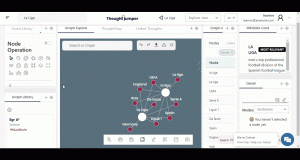What is a Knowledge Graph?
The underlying fabric of semantic web is linked knowledge graphs; interweaving concepts, common understanding, linking millions of things, information, devices, opinions and culture. Knowledge graphs provide structure, meaning, encapsulation and context to a map of clustered human understanding; aided with technology; such that it can help find similar, related and diverse entities. Building this global repository of knowledge is a promise of the future of an empowered generation.
What can a knowledge graph help with?
Knowledge graphs can help with
- efficient ways of enriching existing data
- efficiently filtering, linking, clustering data of similar kind
- robust metadata strategies by adopting common taxonomies, ontology and dictionaries
- manageable workflows on data governance
- integration and representation of relevant data on a need to awareness basis
Can you share some examples of a Knowledge Graph?
Knowledge graphs are very powerful and it is beginning to show up in and around us. Google leverages knowledge graph; and so does Microsoft. Siri, Google Search, Uber, AirBNB, Zomato are all examples of a knowledge graph. Some of these are scoped and contextualised knowledge graphs and some of these are relatively open.
What is a Semantic Knowledge Graph?
A semantic knowledge graph can be used to power data integration such that it is possible to automate a lot of redundant and recurring activities humans do.
Knowledge graphs can further the promise of harmonising structured data with appending unstructured data; sometime also borne out as user generated content. Knowledge graphs with human intervention and machine aided linking is our best bet to knit super knowledge graph of sorts.
Technologically, knowledge graphs are a result of advancements of human understanding in:
- mathematical logic
- graph theory
- information retrieval
- computer linguistics
- knowledge representation and reasoning
- the Semantic Web
- machine learning.
The idea of a Semantic Web as per Sir Tim Berners-Lee was to build a linked data landscape that would be heterogeneous and decentralised; however organised authoritarian forces often assume to lock power in silos; as do many corporations with their content strategy. These organisations do so to leverage the concentrated power of knowledge; and in essence spread a misnomer feature and get people to adopt it, so that they can build content for them, and in turn build their business and further their eco-system but limit the access to open data. Over a period of time, these business-centric short-term skewed goals do more harm to the human civilisation than good.
However, as nature sets it right, these controlled silos of knowledge and power break over time and further disintegrate and distribute this knowledge deeper to the periphery of human access. These seasons of information landscaping, gives rise to a knowledge dissemination that may not be otherwise possible.
History of Knowledge Graphs
- 1736: graph theory was born: Leonhard Euler formulated the ‘Königsberg Bridge Problem.’
- 1976: John F. Sowa published his first paper on Conceptual Graphs.
- 1982: The theory of Knowledge Graphs was initiated by C. Hoede, a mathematician at the University of Twente, and F.N. Stokman, a mathematical sociologist at the University of Groningen.
- 1999: Resource Description Framework (RDF) Model was published as a W3C Recommendation to lay a foundation for a Semantic Web.
- 2001: Tim Berners-Lee, Jim Hendler and Ora Lassila published.
- 2006: the DBpedia project created a seed for the emergence of the Linked Open Data cloud by transforming Wikipedia content into linked data.
- 2012: Google introduced their Knowledge Graph, and since then a lot of companies have started to build their own projects using knowledge graphs in various flavours.
- 2018: The GQL Manifesto was published to agree on a standard for a property graph query language.
History of the Semantic Web
- 1999: Resource Description Framework (RDF) Model and Syntax Specification as a foundation for processing metadata to provide interoperability between applications that exchange machine- understandable information on the Web.
- 2004: Resource Description Framework (RDF) and RDF Vocabulary Description Language 1.0: RDF Schema (RDFS) as a standard for representing information about resources in the WWW. As a major update, RDF 1.1 was published in 2014.
- 2004: OWL Web Ontology Language as a language for defining and instantiating Web ontologies.
- 2008: SPARQL Protocol and RDF Query Language (SPARQL) to retrieve and manipulate data stored in RDF via so-called SPARQL endpoints. As a major update, SPARQL 1.1 was published in 2013.
- 2009: Simple Knowledge Organisation System (SKOS) for representation of thesauri, classification schemes, taxonomies, subject-heading systems, or any other type of structured controlled vocabulary.
- 2012: OWL 2 Web Ontology Language as an ontology language for the Semantic Web with formally defined meaning.
- 2012: R2RML, a language for expressing customized mappings from relational databases to RDF datasets.
- 2014: JSON-LD as a JSON-based serialization for Linked Data


